

Find the probability that a student's favorite type of music is jazz.
Round answer to three decimal places.
What do you think n(E) = n(students whose favorite type of music is jazz) is?
If you said 24 you are correct. 24 students indicated that their
favorite type of music is jazz.
What do you think n(S) = n(students surveyed) is?
If you said 128 give yourself a pat on the back. If you total 51 + 24 + 33 + 5 + 15 you get 128.
Putting this together in the Empirical Probability formula you get:
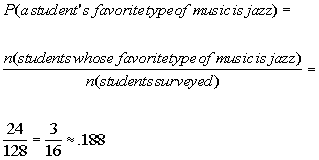
*putting in the numbers found above
*reducing the fraction
*rounding to 3 decimal places
Find the probability that a student's favorite type of music is classical.
Round answer to three decimal places.
What do you think n(E) = n(students whose favorite type of music is classical) is?
If you said 5 you are correct. 5 students indicated that their
favorite type of music is classical.
What do you think n(S) = n(students surveyed) is?
If you said 128 give yourself a pat on the back. If you total 51 + 24 + 33 + 5 + 15 you get 128.
Putting this together in the Empirical Probability formula you get:
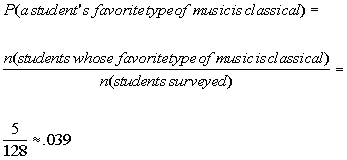
*putting in the numbers found above
*rounding to 3 decimal places
Find the probability that you are dealt a jack. Round answer to
three decimal places.
What do you think n(E) = n(jacks) is?
If you said 4 you are correct. There are 4 jacks in a deck of
cards.
What do you think n(S) = n(cards in a deck) is?
If you said 52 give yourself a pat on the back. There are 52 cards
in a deck.
Putting this together in the Theoretical Probability formula you
get:
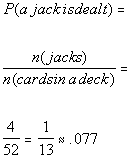
*putting in the numbers found above
*reducing the fraction
*rounding to 3 decimal places
Find the probability that you are dealt a heart or club. Round
answer to three decimal places.
Let's break it down first by finding each separate probability.
P(a heart is dealt)
What do you think n(E) = n(hearts) is?
If you said 13 you are correct. There are 13 hearts in a deck
of cards.
What do you think n(S) = n(cards in a deck) is?
If you said 52 give yourself a pat on the back. There are 52 cards
in a deck.
Putting this together in the Theoretical Probability formula you
get:
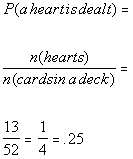
*putting in the numbers found above
*reducing the fraction
*rounding to 3 decimal places
P(a club is dealt)
What do you think n(E) = n(clubs) is?
If you said 13 you are correct. There are 13 clubs in a deck of
cards.
What do you think n(S) = n(cards in a deck) is?
If you said 52 give yourself a pat on the back. There are 52 cards
in a deck.
Putting this together in the Theoretical Probability formula you
get:
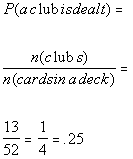
*putting in the numbers found above
*reducing the fraction
*rounding to 3 decimal places
Putting the two probabilities of mutually exclusive events together
we get:
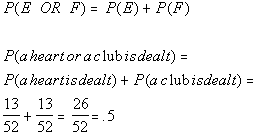
*putting in the numbers found above
*rounding to 3 decimal places
Find the probability that you are dealt a heart and a club. Round
answer to three decimal places.
So what would the probability of this event be????
If you said 0, you are right on. Since n(a card with a heart and
a club) is 0, the probability will be 0.
Find the probability that you are dealt an ace and a spade. Round
answer to three decimal places.
What do you think n(E) = n(ace AND spade) is?
If you said 1 you are correct. There is 1 card in a deck of cards
that has both an ace and a spade on it.
What do you think n(S) = n(cards in a deck) is?
If you said 52 give yourself a pat on the back. There are 52 cards
in a deck.
Putting this together in the Theoretical Probability formula you
get:
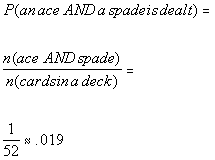
*putting in the numbers found above
*rounding to 3 decimal places
Find the probability that you are dealt an ace or a spade. Round
answer to three decimal places.
Let's break it down first by finding each separate probability.
P(an ace is dealt)
What do you think n(E) = n(aces) is?
If you said 4 you are correct. There are 4 aces in a deck of cards.
What do you think n(S) = n(cards in a deck) is?
If you said 52 give yourself a pat on the back. There are 52 cards
in a deck.
Putting this together in the Theoretical Probability formula you
get:
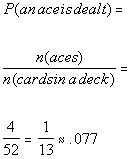
*putting in the numbers found above
*reducing the fraction
*rounding to 3 decimal places
What do you think n(E) = n(spades) is?
If you said 13 you are correct. There are 13 spades in a deck
of cards.
What do you think n(S) = n(cards in a deck) is?
If you said 52 give yourself a pat on the back. There are 52 cards
in a deck.
Putting this together in the Theoretical Probability formula you
get:
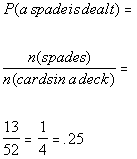
*putting in the numbers found above
*reducing the fraction
*rounding to 3 decimal places
We found this probability to be 1/52 in the Answer/Discussion to problem 2d.
Putting the probabilities of non mutually exclusive events together
we get:

*putting in the numbers found above
*rounding to 3 decimal places
Find the probability that 2 freshmen, 2 sophomores and 2 juniors are
selected. Round answer to three decimal places.
What do you think n(E) = n(2 freshmen, 2 sophomores and 2 juniors are selected) is?
Since we are counting draws that means we are counting groups of names, which means we need to use combinations to count them. If you need a review on combinations, feel free to go to Tutorial 57: Combinations.
If you said 21168 you are correct.
Let's see how we get that number.
Here is what the committee looks like: we would have to have 2 freshmen, 2 sophomores and 2 juniors to meet this condition:
2 FRESHMEN 2 SOPHOMORES
2 JUNIORS
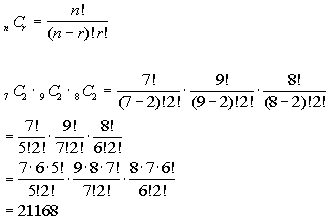
*Comb. of n = 7 freshmen taken r = 2 at a time
*Comb. of n = 9 sophomores taken r = 2 at
a time
*Comb. of n = 8 juniors taken r = 2 at a time
*Expand 7! until it gets to 5!, 9! until it gets to 7!, and 8! until it gets to 6! which are the larger !'s in the den.
*Cancel out 5!'s, 7!'s, and 6!'s
If you have a factorial key, you can put it in as 7!, divided by 5!, divided by 2! times 9!, divided by 7!, divided by 2!, times 8!, divided by 6!, divided by 2! and then press enter or =.
If you don't have a factorial key, you can simplify it as shown above
and then enter it in.
If you said 1344904 give yourself a pat on the back.
Again you would have to use combinations to figure this one out.
Overall, there are 7 freshmen, 9 sophomores, 8 juniors, and 10 seniors
for a total of 34 students, taken 6 at a time.
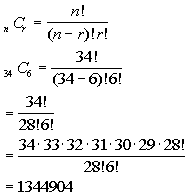
*Eval. inside ( )
*Expand 34! until it gets to 28!
which is the larger ! in the den.
*Cancel out 26!'s
If you have a factorial key, you can put it in as 34!, divided by 28!, divided by 6! and then press enter or =.
If you don't have a factorial key, you can simplify it as shown above
and then enter it in.
Putting this together in the Theoretical Probability formula you
get:
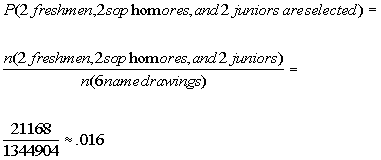
*putting in the numbers found above
*rounding to 3 decimal places
Find the probability that only seniors are selected. Round answer
to three decimal places.
What do you think n(E) = n(seniors) is?
Since we are counting draws that means we are counting groups of names, which means we need to use combinations to count them. If you need a review on combinations, feel free to go to Tutorial 57: Combinations.
If you said 210 you are correct.
Let's see how we get that number.
Here is what the committee looks like: we would have to have only seniors to meet this condition:
6 SENIORS
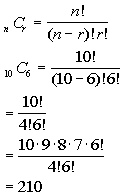
*Comb. of n = 10 seniors taken r = 6 at a time
*Eval. inside ( )
*Expand 10! until it gets to 6! which is the larger ! in the den.
*Cancel out 6!'s
If you have a factorial key, you can put it in as 10!, divided by 4!, divided by 6! and then press enter or =.
If you don't have a factorial key, you can simplify it as shown above
and then enter it in.
As shown in Answer/Discussion to problem 3a, n(S)
= n(6 name drawings) = 1344904.
Putting this together in the Theoretical Probability formula you
get:
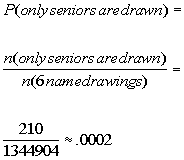
*putting in the numbers found above
*rounding to 4 decimal places
Note I carried this out 4 decimal places since
that was the first non zero digit.
Find the probability that a six is rolled the 1st time and an odd number
is rolled a 2nd time. Round answer to three decimal places.
Let's break it down.
What do you think n(E) = n(6's on the die) is?
If you said 1 you are correct. There is 1 number 6 on a die.
What do you think n(S) = n(numbers on a die) is?
If you said 6 give yourself a pat on the back. There are 6 numbers on a die.
Putting this together in the Theoretical Probability formula you
get:
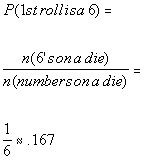
*putting in the numbers found above
*rounding to 3 decimal places
What do you think n(E) = n(odd numbers on a die) is?
If you said 3 you are correct. There is 3 odd numbers on a die.
What do you think n(S) = n(numbers on a die) is?
If you said 6 give yourself a pat on the back. There are 6 numbers on a die.
Putting this together in the Theoretical Probability formula you
get:
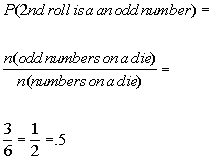
*putting in the numbers found above
*rounding to 3 decimal places
Putting the probabilities of two events that are independent together
we get:
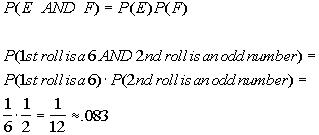
*putting in the numbers found above
*rounding to 3 decimal places
Find the probability that a number less than or equal to 2 is rolled
the 1st time and an even number is rolled the 2nd time. Round answer
to three decimal places.
Let's break it down.
What do you think n(E) = n(numbers less than or equal to 2) is?
If you said 2 you are correct. There are 2 numbers that are less than
or equal to 2 on a die.
What do you think n(S) = n(numbers on a die) is?
If you said 6 give yourself a pat on the back. There are 6 numbers on a die.
Putting this together in the Theoretical Probability formula you
get:
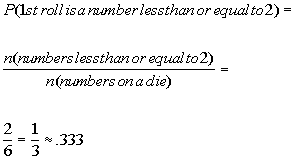
*putting in the numbers found above
*rounding to 3 decimal places
What do you think n(E) = n(even numbers on a die) is?
If you said 3 you are correct. There is 3 even numbers on a die.
What do you think n(S) = n(numbers on a die) is?
If you said 6 give yourself a pat on the back. There are 6 numbers on a die.
Putting this together in the Theoretical Probability formula you
get:
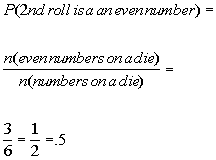
*putting in the numbers found above
*rounding to 3 decimal places
Putting the probabilities of two events that are independent together
we get:

*putting in the numbers found above
*rounding to 3 decimal places
Last revised on May 16, 2011 by Kim Seward.
All contents copyright (C) 2002 - 2011, WTAMU and Kim Seward. All rights reserved.